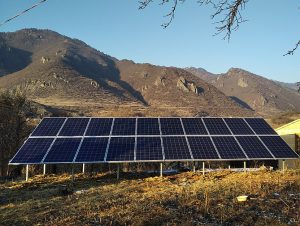How the Inflation Reduction Act Affects Commercial Solar in 2023 in the USA
The Inflation Reduction Act (IRA) is a piece of legislation that aims to lower the rate of inflation in the United States. One of the ways it does this is by reducing the cost of certain goods and services, including commercial solar energy.

The Benefits of Commercial Solar Energy
Solar energy has become increasingly popular in recent years, due in part to its environmental benefits and the falling costs of solar panel technology. Commercial solar systems, which provide electricity to businesses, schools, and other organizations, can be a cost-effective alternative to traditional fossil fuel sources of energy.
The Incentives Provided by the IRA
The IRA aims to reduce the cost of commercial solar energy by providing tax credits and other incentives to businesses that invest in solar energy systems. These incentives can help offset the upfront cost of installing a solar system, making it more financially viable for businesses.
One of the main incentives provided by the IRA is the Investment Tax Credit (ITC). This credit allows businesses to claim a credit on their federal tax return equal to a percentage of the cost of their solar energy system. The ITC currently stands at 26%, meaning that businesses can claim a credit equal to 26% of the cost of their solar system. This credit can be used to reduce the amount of taxes a business owes, or it can be carried forward to future tax years if it is not used in the current year. The IRA extended the tax credit back to 30%, make the investment even more compelling for businesses with tax liability.
The IRA also provides other incentives for businesses that invest in solar energy, such as grants and loans. These incentives can help businesses offset the upfront cost of installing a solar system, making it more financially viable for them. This funding helps to encourage the development of new technologies that can make solar energy more efficient and cost-effective.
Overall, the incentives provided by the IRA are designed to make solar energy more financially viable for businesses and encourage the adoption of solar energy as a source of electricity. These incentives can help businesses save money on their energy costs and reduce their carbon footprint, while also helping to reduce the overall cost of solar energy.
Reducing the Cost of Solar Energy
In addition to these incentives, the IRA also aims to reduce the overall cost of commercial solar energy by encouraging the development of new technologies and reducing the cost of solar panel materials. The act provides funding for research and development into new solar technologies, as well as funding for projects that aim to reduce the cost of solar panel materials. 
Conclusion
Overall, the Inflation Reduction Act has had a positive impact on commercial solar energy in the United States. The tax credits and other incentives provided by the act have made it more financially viable for businesses to invest in solar energy systems, and the act has also encouraged the development of new technologies and the reduction of solar panel costs.
As a result, the adoption of commercial solar energy has increased in recent years, and it is likely to continue to grow in the future. This is good news for businesses, as solar energy can provide a cost-effective and environmentally friendly source of electricity. It is also good news for the environment, as the use of solar energy helps to reduce the emission of greenhouse gases, which contribute to climate change. Read our FAQs about commercial solar panels.
Curious how you can take advantage of the IRA and the extended Federal Tax Credit for your business? Reach out to get a proposal.